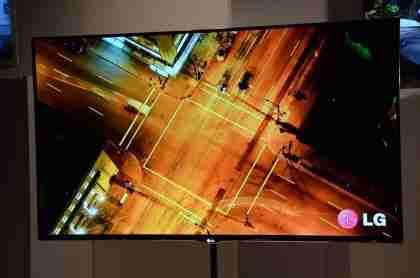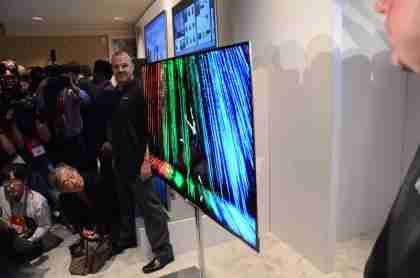LG kicked off CES 2012 in style, pulling the sheet off a rather amazing new TV: a 55in Organic Light Emitting Diode (OLED) model.
Previously, the technology had been limited to small screen size, predominantly appearing on smartphone models and relatively small TVs that were more for demonstration than use in a real home. With this announcement, OLED takes one step closer to being a reality for every-day TV.
The benefits of the technology are that each pixel is self-illuminating, making for impressive black and contrast levels, plus incredibly thin sets, as there's no need to house a bulky backlight.
Looking through the list of available specs shows that LG's TV should be pretty impressive. It has a contrast ratio of over 100,000,000:1 (Panasonic's top plasma TVs currently have a 5,000,000:1 contrast ratio), response time of less than 0.1 microseconds, the promise of better colour than is possible with LCD or plasma, and the set is just 4mm thick.
Specs are one thing, but seeing the television up close and personal is simply incredible. The demo footage took full advantage of the screen's incredible contrast ratios, showing a brightly lit city with a black night sky in the background. It looked incredible. Getting up close, blacks were truly black, but the bright white of the city lights jumped out from the screen.

The incredible contrast of the OLED TV really makes the most of any scene and this picture doesn't do it true justice.
Full colour was stunning, too. Bright vivid colours really shine from this set, having the effect of making LG's LCD TVs that were also on display look a little poor in comparison.
At just 4mm thick, the screen is almost impossible thin: stand to the side of it and it's barely there at all. Impressively, standing to the side makes no effect on the colour or brightness of the image, as the viewing angles are so high.

OLED means the viewing angles are incredible, while the TV is just 4mm thick.
As you'd expect, this model supports 3D, using LG's passive glasses to produce an image. We didn't see any 3D footage on it, so can't comment on the quality, although the speed and brilliant colours of the display lead us to believe that there'll be no problems.
There are some questions to be answered, though. For starters, a price and release date would be good. Based on previous experience of this kind of technology we would imagine that this TV will be incredibly expensive.
Then there's the matter of lifespan. Current OLED technology has the Blue OLEDs reducing to half brightness the fastest at around 14,000 hours or five years at eight hours a day. Compared to LCD and plasma which will fall to half brightness after roughly 25,000 to 40,000 hours, there's quite a difference. LG couldn't confirm at the time of writing if this issue has been addressed.
Even so, this is clearly a step in the right direction and OLED brings back the image quality of CRT with all the benefits of a flat panel.












